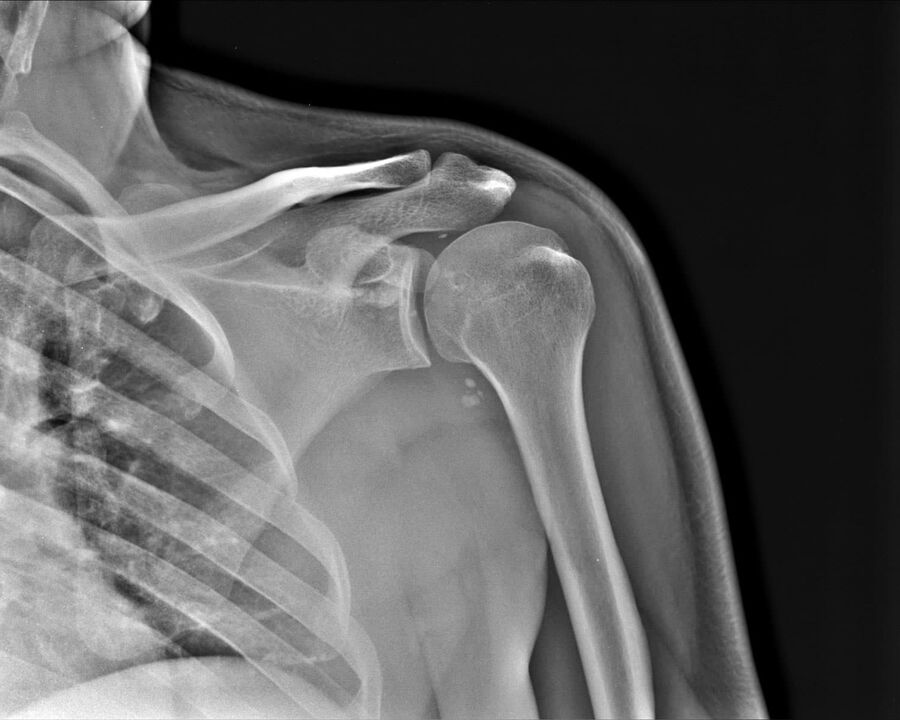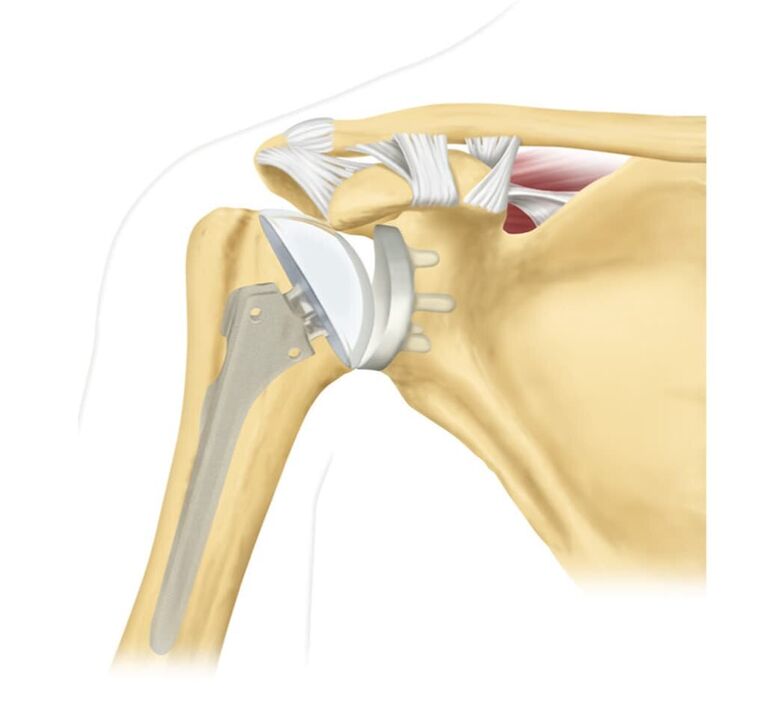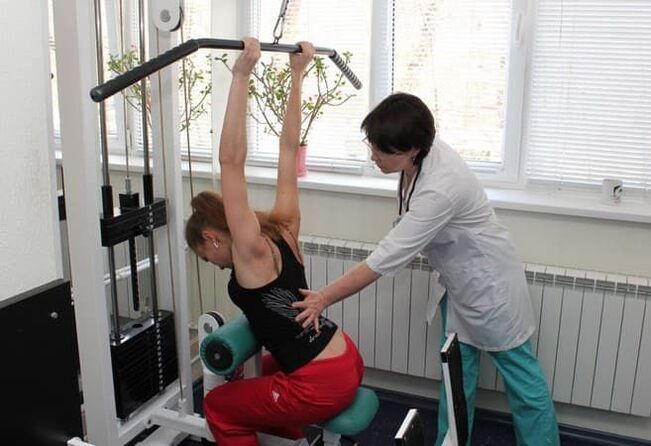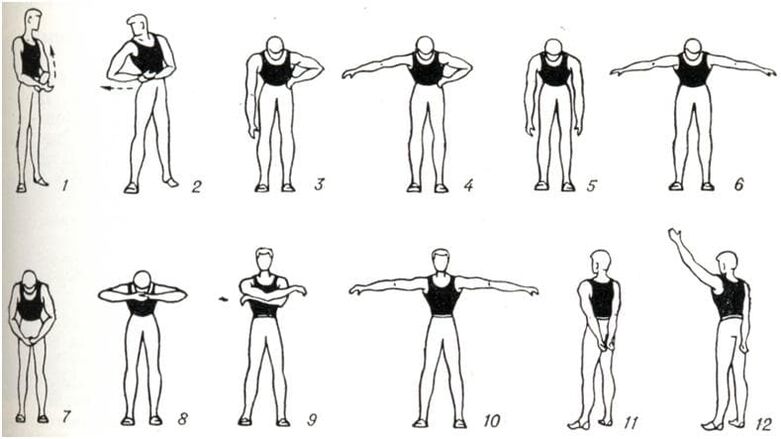Arthritis (OA) is a degenerative disease of cartilage tissue in which the normal functioning of joints is disrupted. In most cases, the disease is chronic. Shoulder arthritis is characterized by pain and gradual loss of function of the hand. Most often, the pathology is detected in old age. Osteoarthritis is caused by aging body changes, shoulder injuries, birth defects, and frequent stress on the shoulder. If the patient experiences discomfort in the shoulder and neck area, it is necessary to see a doctor and go to the doctor. With the help of a complex effect, it is possible to prevent the development of degenerative changes.
What is shoulder joint disease?
Shoulder arthritis - damage to the cartilage tissue of the joint, in which degenerative changes occur. The blood supply is interrupted in the cartilage tissue, so it cannot receive adequate amounts of nutrients and oxygen.At risk are people who daily bear excessive stress on the shoulders and have congenital defects in the joint tissues.In the early stages, the patient feels pain, but the normal function of the shoulder is preserved. If the triggers are not eliminated, the disease will cause serious harm to health.
Diagnosis plays an important role in the treatment of joint disease. With the help of X-rays, it is possible to determine the exact cause of the disease and the extent of the damage.
Anatomy background
Congenital disorders of the structure of joints and connective tissues can become the cause of the occurrence of the disease. If a person has features in the structure of the scapula, then even a normal load can provoke the appearance of arthropathy. To avoid problems, you'll need to take precautions and see your doctor regularly. Congenital dysplasia can be managed with massage therapy and exercise.
Causes and risk factors
All elderly people are at risk.According to WHO statistics, the likelihood of joint disease after the age of 45 increases significantly.By the age of 65, more than 50% of people have this disease. Among the reasons that provoke the early onset of the disease are:
- damage to the rotator cuff of the shoulder;
- shoulder injury;
- constant stress related to sports or work;
- infectious and autoimmune pathologies;
- fat;
- improper conversion.
The older you get, the higher your risk of osteoarthritis.
View
The failure of cartilage tissue is divided into primary and secondary. The diagnosis of primary joint is made if there are no comorbidities. It is usually discovered in old age. The reason for its appearance is age-related changes. Secondary perspective occurs due to trauma or due to the background of another disease. In addition, the disease is also classified by location. Degenerative changes in the shoulder can occur in the shoulder or collarbone region itself.
Developmental stages and symptoms
Symptoms depend on the stage of development of shoulder joint disease. The disease is divided into three stages:
- The first. . . There are intense pain at night, the function of the shoulder and neck is preserved.
- Second letter. . . When moving the hand, hear a crunching sound, constant pain, limited shoulder movement.
- The third day. . . The pain is severe, the arm is immobilized in one position, protrusions can be seen in the affected area, strong deformity of the joint can be seen on the x-ray.
The disease may not develop for a long time. If a person continues to shoulder the burden, the condition will get worse.
Which doctor to contact?
Shoulder arthritis is treated by different doctors. The initial examination is done by a therapist or rheumatologist. In addition, the following specialists may be involved in treatment:
- operated doctor;
- orthopedic doctor;
- neuroscientist.
In most cases, the treatment regimen is outlined by a rheumatologist.The help of a surgeon is necessary if the disease requires surgical treatment or intra-articular manipulation.A neurologist should be consulted if the nerve bundle is compressed due to disease.
Only after a diagnostic examination will a therapist or rheumatologist determine if the assistance of other specialists is needed.
Diagnose

Hardware and laboratory testing, as well as manual testing, are used for accurate diagnosis. First of all, an inspection is carried out with various tests. The history of the person being studied. All this helps to make a preliminary diagnosis. In addition, MRI and X-ray are used to determine the degree of narrowing of the joint cavity, the condition of blood vessels, bursa, tendons.
Manual test
Manual examination includes palpating the affected area and performing diagnostic tests. Pain usually occurs on palpation of the clavicle joint. If a person has problems with bringing their hands behind their head, then this may signal the presence of fibromyalgia. On manual examination, your doctor should be able to detect inflammation. Information obtained during manual examination plays an important role in diagnosis.The examination should be performed by an experienced rheumatologist or physician, so as not to cause harm during testing and functional testing.
Tool method
Instrumental research methods allow you to identify:
- degree of narrowing of the joint cavity;
- joint surface is not flat;
- localization of arthrosis.
After using instrumental diagnostic methods, the necessary therapy is selected. For diagnosis, X-ray, CT or MRI are used. These methods provide the necessary information. Instrument testing may be repeated during treatment.

Laboratory
Laboratory tests allow you to assess the general condition of the body, as well as rule out arthritis. First, blood is taken for analysis. With arthropathy, all clinical and biochemical blood tests were within normal limits. With arthritis, the erythrocyte sedimentation rate, the amount of immunoglobulins and other markers of inflammatory processes in the body are significantly increased. Based on the results obtained, the doctor makes a final diagnosis and selects an effective treatment regimen.
For accurate results, donate blood in the morning on an empty stomach.
Treatment
The treatment approach is complex. Medications, physiotherapy, physiotherapeutic exercises are used. If the disease is advanced or does not respond to treatment, surgical methods will be applied. Basic principles of therapy:
- pain relief;
- prevent the development of the disease;
- initiates mechanisms of cartilage repair.
In the early stages, results are achieved through the use of drugs.It is important to rule out provoking factors. Stable remission is achieved through physical therapy and exercise.
Medicine
The following classes of drugs may be used for treatment:
- non-steroidal anti-inflammatory;
- chondroprotectors;
- corticosteroid drugs;
- vasodilators.
NSAIDs and corticosteroids are used to relieve pain. They apply for a limited time. Chondroprotectors can accelerate cartilage tissue repair. Vasodilators help improve blood flow and reduce spasms of small vessels.
Before prescribing this or that drug, it is necessary to carefully study contraindications. Only a doctor can correctly combine all drugs.
Surgery
Surgical intervention is performed only as a last resort, when irreversible degenerative processes have already occurred. The reason for the operation is:
- lack of effect from conservative therapy;
- the appearance of complications;
- the appearance of severe degenerative changes.
If the joint has lost its original shape, arthroplasty is performed.The diseased joint is replaced with an artificial joint. The surgery is complicated and requires a high level of expertise of the surgeon. Lumbar puncture and arthroscopy may also be done to treat joint disease.
Puncture
Lumbar puncture is performed if a large amount of fluid has accumulated in the joint cavity. In addition, this procedure is performed on inflammatory cases to determine the type of infection. Removing excess fluid helps to reduce pressure on the shoulder joint and increase joint mobility. The procedure is minimally invasive, so recovery from completion occurs as soon as possible. Amniocentesis has indications and contraindications. It is used only in cases of fluid accumulation in the joint capsule or if an infectious complication of joint disease is suspected.
Arthroscopy
Arthroscopy is a minimally invasive surgical technique to remove damaged shoulder cartilage. The surgery is performed using an endoscope and a tiny camera. The advantage of this method of treatment is the quick recovery of function. Removing damaged cartilage allows you to reduce stress and restore joint mobility. The downside of the process is that access to the affected area is somewhat limited.
Endoscopic
Arthroscopy is the complete replacement of a damaged joint with a biocompatible substance.Titanium construction is commonly used. Surgery allows you to get rid of even stage 3 arthritis. Long-term rehabilitation is performed after endoscopy. As a result, it is possible to completely eliminate affected areas and chronic pain, as well as restore mobility of the shoulder joint.

This operation is not always possible. In older people, the rehabilitation period is much more difficult. Other treatment options are used before arthroplasty is indicated.
Physical therapy
Physical therapy procedures play an important role in getting rid of shoulder osteoarthritis. With their help, it is possible to restore normal joint mobility and reduce the severity of pain. The following procedures are performed:
- electrophoresis;
- local cryotherapy;
- acupuncture therapy.
Physiotherapy can be applied if there are no acute manifestations of the disease (severe pain, limited mobility). Regular contact will completely eliminate the feeling of discomfort. Any procedure must be performed by a qualified technician.Before going to physical therapy rooms, you need to consult your doctor.
Kinesitherapy

Kinesitherapy refers to the use of active and passive methods for shoulder rehabilitation. If the disease is mild, the patient can start using active recovery methods through exercise. Passive methods include external exposure through massage or mechanical therapy. Therapeutic movements help quickly get rid of the symptoms of shoulder osteoarthritis.
Passive recovery through mechanical therapy is available to people of all ages.
Exercise therapy
Physical therapy exercises allow you to put a load on the muscles and restore mobility of the shoulder joint. Mostly static exercises are used. Dynamic loads with active shoulder rotation are not desirable. The following exercises can be performed:
- Shoulder sway- Ask for starting position, sitting in a chair and placing your hands on your knees. Relax your shoulders, then start swinging your elbows. At the same time, both hands on the knees.
- Slow motion- You need to sit in a chair and put your hands on your knees, then slowly begin to rotate your shoulders with short pauses. Circular motion is done back and forth.
Physical therapy can only be used during periods of remission, when pain and limitation of movement are virtually absent.

Massage
Massaging the affected area allows you to get the following effects:
- improve tissue nutrition;
- reduce swelling;
- toning the muscles;
- remove pain.
We recommend that all actions be performed by a qualified professional.When self-massaging, strong pressure and sudden movements should be avoided.The results of the massage effect can be seen within a few weeks of regular use.
The massage should be accompanied by other activities. If a person performs exercises from the fitness therapy complex and visits a massage parlor, he will achieve excellent results.
Mechanical therapy

Mechanics therapy is a set of exercises performed on specialized mechanisms. This method allows you to recover in the shortest possible time. Mechanical therapy is ideal for rehabilitation after surgery. Special mechanisms allow you to adjust the load, allowing for faster recovery of muscles and ligaments. All actions are performed in static conditions. Rehabilitation mechanics classes should be conducted with an instructor. He will choose exactly the required load and emulator.
Joint pull force
Joints are tensioned with specialized equipment. With this process, the following effects can be achieved:
- improve blood circulation;
- expand joint space;
- Relieve stress from ligaments.
Narrowing of joint space is one of the main manifestations of joint disease. With this trick, you can improve the situation. The load level is selected individually. Initially, traction was performed with minimal weight.
Before prescribing joint traction, it is necessary to conduct an examination of possible contraindications.
Folk method
Traditional methods allow you to relieve pain and accelerate the recovery of cartilage tissue. The following medications can be used:

- Burdock leavesCrush fresh burdock leaves until soft and apply on the affected area for 30-60 minutes. Fixation is done with gauze.
- Salt compress- 50 g of salt is dissolved in 450 ml of water, then put gauze in the liquid. The gauze is removed, heated, and applied to the shoulder for 45 minutes.
- gelatin- 2 teaspoons of gelatin will need to be diluted in 100 ml of warm water, then boil the liquid. Gelatin is taken 1 time per day before meals. It promotes cartilage tissue repair.
Traditional methods will help to achieve good results in therapy. It is recommended to use them during remission.
Diet for joint disease
With any type of joint disease (shoulder, wrist, ankle), you need to provide the body with adequate nutrients for the cartilage tissue to recover quickly. You will need to add the following foods to your diet:
- nuts;
- bran;
- viscous jelly;
- buckwheat porridge;
- egg.
The diet needs to be balanced. You can take vitamin supplements to get the vitamins and minerals you need. Eat 4-5 times a day. During the treatment of joint diseases, alcoholic beverages and sweets are excluded. If a person wants long-term remission, then he will need to adhere to the principles of proper nutrition on an ongoing basis.
Complications and prognosis
Prognosis depends on the age of the person, the extent of the lesion, the individual characteristics of the organism. At a young age, it is possible to fully restore cartilage tissue and joint function. As you get older, you'll need to follow certain rules to improve your long-term condition. Osteoarthritis of the shoulder responds better to therapy than arthropathy, because the shoulder is very easily isolated from stress. This allows for more effective conservative treatment.
Difference between shoulder joint disease and arthritis
Arthritis and arthritis have similar manifestations, but differ in their clinical picture. The main difference is that arthropathy is a non-inflammatory disease.In the early stages, pain in arthritis only worries the person after exercise, and in arthritis, it happens frequently.Arthritis is a degenerative disease caused by inflammation. Its treatment is slightly different from the treatment of joints.
In order not to confuse these diseases, methods of differential diagnosis are used. Laboratory and instrumental studies will help to accurately determine the presence or absence of inflammation.
Preventive
Prevention of joint disease includes eliminating triggers and maintaining a healthy lifestyle. You will need to do the following:
- for moderate physical activity;
- avoid hypothermia;
- use chondroprotectors;
- avoid hard work;
- reduce body weight to normal.
Preventive actions will help keep joints healthy into old age. People over 45 years old or actively participating in sports should pay special attention to prevention.
conclude
- Osteoarthritis of the shoulder is a degenerative disease in which there is gradual destruction of the cartilage tissue of the joints.As a result, the patient experiences pain and limited range of motion.
- Treatment includesthe use of drugs, performing physiotherapy and performing exercises from the complex of physiotherapy exercises.
- At an early stage of the disease process, the prognosis for complete recovery is favorable.
- Prevention can greatly reduce your chances of developing shoulder osteoarthritis.



























